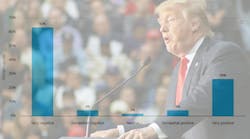Forester University: A New Educational Model
Education as we know it is on the verge of a revolution. This past Fall, Stanford opened up its doors to anyone, anywhere interested in taking its Artificial Intelligence course. Thirty-five thousand virtual students enrolled and studied alongside Stanford’s student body, turning the traditional education system on its head. Not only did the program break down the traditional enrollment walls, it introduced a new educational model asserting that anyone anywhere should be able to get a world-class education.
We launched Forester University with a similar ideal: industry experts and education when you want, where you want. Why can’t a budget-strapped facilities manager in Elko, NV, learn from, and interact with, a lighting expert on the East Coast? Why can’t an energy manager connect with water efficiency experts to discuss the water-energy nexus to help resolve his project’s challenges? And why can’t they both skip the travel budget and time, and learn from the comfort of their office or in the field on their smart phone? With today’s technology and changing ideas regarding education, they can.
Stanford’s foray into open source education isn’t the first of its kind. MIT’s successful OpenCourseWare (OCW) initiative (est. 2001) today enables open access to over 1,700 MIT courses, and the widely discussed Khan Academy (est. 2006), which started as a YouTube tutoring experiment, has grown into an international movement exploring new ways to deliver education. Additionally in the business sector, many organizations, like Forester Media, have been and are experimenting with different educational formats and delivery.
At the base of these new explorations is an educational format (termed by some as “education 2.0″ or “learning 2.0″), which delivers topics in a technology-dependent and personalized format (e.g., timing, delivery, etc.) and encourages participation learning. Virtual learning (e.g., webinars, virtual workshops, etc.) offers an ideal format for education 2.0, offering the technology and flexible environment required, as well as an open, virtual community that stretches across the globe and provides ongoing interaction (through platforms and social sharing) that enables participatory learning.
At Forester University our first leap into education 2.0 has been our inaugural webinar series, which has featured webinars specific to each of our magazine industries (e.g., Maximizing Lighting Efficiency), as well as webinars that stretch across industries bringing experts and ideas together (e.g., Water-Energy Nexus, From Gas to Energy, etc.). Offering the webinars on a virtual platform has opened up our industries, audience, and experts to the world. In a few short months, we have already had attendees from all 50 states and 10+ countries, as well as a number of on-demand requests from countries in opposite time zones; and this global conversation continues to grow. Our virtual webinar platform combined with social sharing technology has enabled us to create an environment that encourages exchange, innovation, and participation through virtual presentations, live interaction (e.g., polls, Q&A, etc.), and ongoing discussion (e.g., Twitter). But most importantly, our webinar series has enabled us to bring the experts to you on your terms, offering you the ability to choose what you want, when you want, and interact with it how you want.
While response to our webinar series has been outstanding (500+ at times) and feedback extremely positive, looking at a program like Stanford’s and the possibilities of how education 2.0 can change our professional development are intriguing. What is remarkable about Stanford’s program is the overwhelming response, commitment, and participation. While the official analysis hasn’t been released at the writing of this article, the sheer number of participants suggests we may be nearing the tipping point of education 2.0-the point where technology meets environmental and mindset demand.
Technology is firmly at the heart of the education 2.0 innovation, as it is any creative disruption, providing the tools and facilitation for a new idea to form and thrive. The central and most influential technology in this education 2.0 development is the increasing sophistication of the Internet, coupled with the rise of social sharing. Once just an information portal, the addition of social sharing has transformed the Internet into an interactive destination where international users can connect and interact real-time in seconds. In fact, in writing this article I posted a call for the Stanford AI class participants to a few of my social circles, and within less than an hour, I had five responses (none whom I knew, and two being international) willing to talk about their experience. This connection and interactivity is powerful when directed toward education, because it enables development and continuance of connections and discussions. At Forester University, the Internet has enabled us to open the platform and discussion to the world, but it’s the combination of Internet and social sharing that enables us to keep the conversation open. We’ve started live tweeting our webinars and continue the discussions via Twitter post-webinar; and in the future, we are looking to facilitate study and innovation groups with real-time chat and video.
Delivery platforms have also greatly improved in the last couple years, helping the growth of education 2.0 with streamlined facilitation. Instead of delivering static lectures with pictures, we can deliver an interactive learning experience, including dynamic presentations, chat, polls and real-time results, and Q&A sessions. But webinars are only the beginning. We’re also currently building a webcast library that will offer on-demand versions of our live webinars with certificates; exploring developing self-paced study modules; and developing ongoing curriculum with study group interaction.
Mobile technology is quickly becoming a leading influential technology as well, opening up the classroom beyond the office. Many platforms-including ours-offer applications enabling webinar access, viewing, and interaction from your smart phone. According to C. Schreier, a participant in our recent lighting webinar, “The app works great! I was able to catch the webinar even though I was onsite.” Since its launch, we’ve seen an increase in mobile use, which we expect to grow on both the presenter and the audience side.
While technology innovation has catapulted the growth of new education, it has done so thanks to the demand stemming from our economic environment and growing global mindset. Prior to starting Forester University, our conversations with industry professionals led to one topic: a gap between knowledge supply and demand. The new economic conditions and global mindset had created new needs that weren’t being met; at Forester University we set out to meet those needs.
In the business sector, our current economic conditions have catapulted an interest in education 2.0, especially in distance learning. Resource and budget cutbacks have led to widened responsibilities and cross-functional supervision, often in areas unfamiliar and without training support. On one of our recent webinar polls, the majority of attendees indicated they were participating specifically because they had taken on responsibilities beyond their knowledge or job scope and needed to get up to speed quickly. With travel and training budgets cut and fewer resources, professionals are looking for education that fits their specific interest, budget, and schedule. Online webinars like Forester University’s, offer access to industry experts and the ability to personalize your education (e.g., level, topic focus, length, delivery, etc.) without the travel time or cost. Additionally, recorded versions of the webinars allow you to review or watch it at your leisure.
Our growing global mindset has also motivated a shift toward education 2.0 and virtual learning. Thanks to the growth of the Web, the global community has become not only accessible, but an integrated and normalized part of our lives. With the rise of social sharing, the world has become much smaller and accessible, creating-and demanding-access to an international community of professionals across the world. Virtual learning like Forester University offers an environment for individuals across the globe to continue and expand their community.
Is the world ready for widespread education 2.0? While our graduate systems may take some time to transform, the business sector offers a great opportunity for professionals and experts alike to take advantage of the virtual formats and environments available. Why can’t we interface with an expert halfway around the world? We can, and we are!
As we noted, response and feedback has been overwhelmingly positive, which has driven us to focus on new technologies and formats for 2012. Based on feedback from those of you who missed webinars or were referred by webinar participants, we are currently building a library of our recorded webinars in webcast format for on-demand purchase and CEU/PDH certification. Looking at an early 2012 launch date, this is only the beginning of our on-demand offerings. We’re also working with industry experts (including a few of our authors) to develop full course curriculum with built in self-study, self-paced learning, and live classroom study group modules to meet your individual study group needs. And we are looking at offering some interactive events (e.g., panels, workshops, live broadcasted events) to offer a heightened level of interaction for those of you looking to visit the sites virtually and meet face to face with the experts-but still from the comfort of your office chair.
As we evolve our program, we’re looking to hear from you.

